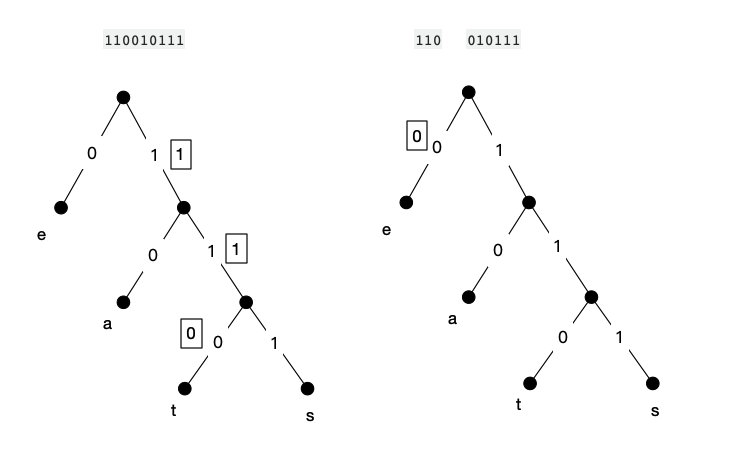前缀码
这玩意很有意思啊,假设我们用固定长度的5个byte位来表示26个英文字母,比如:
- 00000:a
- 00001:t
这样当我们想传递单词at的时候,就可以传输01的电信号00000001。但是接下来,试想有没有可能采用下面的形式来表示数据呢?

即:
- e的编码为:0
- a的编码为:10
- t的编码为:110
- s的编码为:111
这样当我们想传输teas的时候,就可以传输
| t | e | a | s |
|---|---|---|---|
| 110 | 0 | 10 | 111 |
即传输110010111。
这样带来的挑战是什么?就是我们没有办法按照固定长度来分割接收到的二进制数据,但是我们可以比照上面的那个二叉树,直到到达某一个树叶为止。
比如将上面的过程逆着来:


然后像上面这种非固定长度的编码就是前缀码。
哈夫曼编码
上面是我们随意指定了编码的方式,现在我们需要先构建一颗树,然后再套用到上面的方式中。比如下面这句话:
To be,or not to be:that is the question
然后我们统计各个字符号出现的频率:
- T : 0.03
- o : 0.13
- 空格: 0.18
- b : 0.05
- e : 0.1
- , : 0.03
- r : 0.03
- n : 0.05
- t : 0.15
- : : 0.03
- h : 0.05
- a : 0.03
- i : 0.05
- s : 0.05
- q : 0.03
- u : 0.03
然后我们从中挑选最小的两个值,如果有很多最小的值也没关系,随便挑两个:

然后这里我们就可以把上面的T和,(逗号)去除掉了,加上一个新的频率值:0.06,然后再来挑2个最小值:

然后继续上面的步骤,直到完成下面这幅图:

因为图片太大了,我估计缩小会糊,所以放一下原图的地址
这里说一下构建的方法,依次选择上面列表中最小的点,然后组建成新的顶点,就这样。构建好哈夫曼树之后,就可以套用到上面的二叉树编码中去了。

这样就可以得到例如T的编码就是:00000,,的编码就是00001。
这样的好处就是频率比较高的字符,比如t,它的编码就比较短010。
另外这里总数是1.02,而不是1是因为上面的数据是我用代码算出来的,精度上有点偏差。
哈夫曼树具体代码
这段代码真的是写死我了:
<?php
/**
* Class Leaf
* 记录下各种数据结构的类
*/
class Leaf{
public $value;
public $label;
// 用来构建哈夫曼树
public $leftLeaf;
public $rightLeaf;
// 用来保存最终的编码值
public $code;
/**
* 模拟链表操作,跟树操作无关
* @var $nextLeaf Leaf
*/
public $nextLeaf;
public function __construct($value='',$label='')
{
$this->value=$value;
$this->label=$label;
}
}
/**
* 将字符串转化成上面的类
* @param $string
* @return Leaf
*/
function prepareLeaves($string){
$length=strlen($string);
$result=[];
for ($i=0;$i<$length;$i++){
$data=$string[$i];
!isset($result[$data]) && $result[$data]=0;
$result[$data]++;
}
$prepare=false;
$leaf=new Leaf();
foreach ($result as $word=>$count){
$value=round($count/$length,2);
if (!$prepare){
$prepare=true;
$leaf->value=$value;
$leaf->label=$word;
continue;
}
$newLeaf=new Leaf($value,$word);
$leaf=sortLeaf($leaf,$newLeaf);
}
return $leaf;
}
/**
* 构建哈夫曼树
* @param $leaf Leaf
*/
function createHuffmanTree($leaf){
if (!$leaf->nextLeaf->nextLeaf){
$indexLeaf=new Leaf($leaf->value+$leaf->nextLeaf->value);
$indexLeaf->leftLeaf=$leaf;
$indexLeaf->rightLeaf=$leaf->nextLeaf;
return $indexLeaf;
}
$newLeaf=new Leaf($leaf->value+$leaf->nextLeaf->value);
$newLeaf->leftLeaf=$leaf;
$newLeaf->rightLeaf=$leaf->nextLeaf;
// 插入新的顶点并排序,保证最前面的2个一定是值最小的2个顶点
$leaf=sortLeaf($leaf->nextLeaf->nextLeaf,$newLeaf);
// 递归,并且之前用过的2个顶点不再继续使用
return createHuffmanTree($leaf);
}
/**
* 根据哈夫曼树在其中加上编码值
* @param $leaf Leaf
* @param string $preCode
* @return bool
*/
function getWordCode($leaf,$preCode=''){
if (!$leaf){
return false;
}
if ($leaf->leftLeaf){
$leaf->leftLeaf->code=$preCode."0";
getWordCode($leaf->leftLeaf,$leaf->leftLeaf->code);
}
if ($leaf->rightLeaf){
$leaf->rightLeaf->code=$preCode."1";
getWordCode($leaf->rightLeaf,$leaf->rightLeaf->code);
}
}
/**
* 读取最终的编码值,保存在 result 数组中
* @param $leaf Leaf
* @param $result array
* @return array
*/
function storeResult($leaf,&$result){
if (!$leaf){
return $result;
}
if ($leaf->label){
$result[$leaf->label]=$leaf->code;
}
storeResult($leaf->leftLeaf,$result);
storeResult($leaf->rightLeaf,$result);
}
/**
* 按照从小到大排序叶子节点
* @param $leaf Leaf
* @param $newLeaf Leaf
* @return Leaf
*/
function sortLeaf($leaf,$newLeaf):Leaf{
if ($leaf->value>$newLeaf->value){
$newLeaf->nextLeaf=$leaf;
return $newLeaf;
}
$thisLeaf=$leaf->nextLeaf;
$lastLeaf=$leaf;
if (!$thisLeaf){
$leaf->nextLeaf=$newLeaf;
return $leaf;
}
while ($thisLeaf->nextLeaf && $thisLeaf->value<$newLeaf->value){
$lastLeaf=$thisLeaf;
$thisLeaf=$thisLeaf->nextLeaf;
}
$lastLeaf->nextLeaf=$newLeaf;
$newLeaf->nextLeaf=$thisLeaf;
return $leaf;
}
上面是具体的操作代码,下面是调用:
<?php
$string='To be,or not to be:that is the question';
$indexLeaf=prepareLeaves($string);
$indexLeaf=createHuffmanTree($indexLeaf);
getWordCode($indexLeaf);
$storeResult=[];
storeResult($indexLeaf,$storeResult);
print_r($storeResult);
最终输出的结果:
Array
(
[o] => 0
[ ] => 100
[n] => 10100
[b] => 10101
[i] => 10110
[h] => 10111
[e] => 1100
[:] => 110100
[r] => 110101
[q] => 110110
[a] => 110111
[T] => 111000
[u] => 111001
[,] => 111010
[s] => 111011
[t] => 1111
)
这里有个很有意思的地方,那就是o的编码是最短的,这个问题的答案我在代码中暂时没有找到原因,所以先搁置吧。
























 900
900

 被折叠的 条评论
为什么被折叠?
被折叠的 条评论
为什么被折叠?








